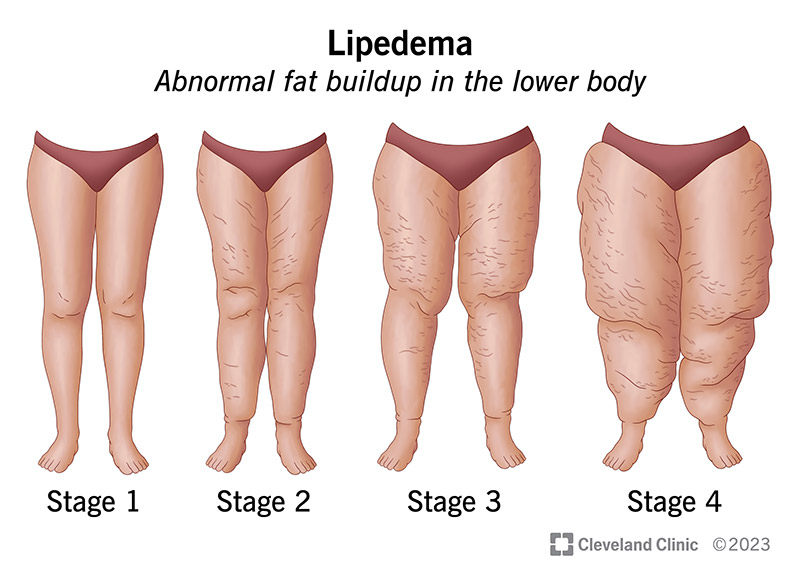Lipedema is an abnormal fat buildup on both sides of your lower body, usually in your legs. But it can also be in your arms. It can cause pain and make daily activities difficult. Lipedema doesn’t respond to diet and exercise like ordinary fat. Although there isn’t a cure for lipedema, treatments can help you feel better.
Advertisement
Cleveland Clinic is a non-profit academic medical center. Advertising on our site helps support our mission. We do not endorse non-Cleveland Clinic products or services. Policy

Lipedema is a long-term condition that causes abnormal fat buildup in the lower part of your body. Lipedema most often involves your butt, thighs and calves. Some people have it in their hips or upper arms. It doesn’t affect your hands or feet.
Advertisement
Cleveland Clinic is a non-profit academic medical center. Advertising on our site helps support our mission. We do not endorse non-Cleveland Clinic products or services. Policy
People sometimes confuse lipedema with having overweight or lymphedema, but these are different conditions. However, lipedema can lead to lymphedema. Many people with lipedema have a body mass index (BMI) higher than 35.
Dieting and exercising can cause you to lose weight in your upper body without changing the areas lipedema affects in your lower body.
You may have more than one type of lipedema at a time, depending on where you have symptoms. Types of lipedema include:
Researchers estimate that 1 in 72,000 people have lipedema. But this number is probably low because lipedema can look like obesity or lymphedema. Another global estimate says 11% of females have lipedema. The condition is rare in males.
Lipedema symptoms include:
Advertisement
The exact cause of lipedema is unknown. But the condition runs in families in 20% to 60% of cases, so you may inherit it. The condition occurs almost exclusively in women.
Lipedema may have a connection to hormones because it usually starts or gets worse during:
Having obesity doesn’t cause lipedema, but more than half of people with this condition have a BMI higher than 35.
You’re more likely to get lipedema if you:
Lipedema can lead to:
A healthcare provider can diagnose you by doing a physical exam and collecting your medical history. Painful fat deposits make lipedema different from ordinary body fat, which doesn’t hurt. Also, people with lipedema have a clear difference in size between their unaffected feet and their affected legs.
Providers don’t have a go-to test they use to diagnose lipedema. But they can do blood tests and imaging to rule out other issues or find other conditions you may have with lipedema.
Tests they may order include:
Lipedema slowly worsens with time in many people. Lipedema stages include:
Researchers haven’t found a cure, but lipedema treatments can help you feel better by reducing pain and inflammation. You can start with simple, noninvasive treatment for lipedema and switch to more complex treatments if needed.
Advertisement
Lipedema treatment may include:
Your provider may suggest noninvasive treatments for lipedema, like:
Liposuction can remove fat and help with pain and mobility. Providers recommend wet-jet assisted liposuction because it’s less likely than standard liposuction to damage your lymph vessels.
If you have lipedema and a BMI higher than 35, your provider may recommend bariatric surgery.
Any medicine or herbal supplement can have side effects. Talk with your provider if you have bothersome side effects.
Advertisement
Complications from liposuction or bariatric surgery may include:
It can take four to six weeks to recover from liposuction. After bariatric surgery, you’ll need several weeks to recover as well. You may need to avoid strenuous activities for six weeks after either procedure.
Lipedema slowly (or quickly for some) gets worse over time for some people. Other people with lipedema have mild symptoms that don’t get worse.
Early diagnosis and treatment may help you avoid complications. Exercising and using compression stockings can give you a better outcome. Liposuction can help you feel better.
Having other conditions like depression, obesity or lymphedema can make lipedema worse. A provider can refer you for counseling, physical therapy or help managing your pain.
Not knowing the exact causes of lipedema makes it hard to avoid. But if you have the risk factors of having lipedema in your family and being female, you can aim to stay at a weight that's healthy for you. Talk to your provider about ways to meet your weight goals.
Follow your provider’s instructions for the treatments they prescribe for you. If you’re not sure when to take medicine or how long to wear compression stockings, just ask. Keeping your regular appointments with your provider will help them see the progress you’re making from one visit to the next.
Advertisement
Your provider may want to see you monthly or every few months to monitor your treatment. Contact them if you’re having issues with any of your treatments or if they don’t seem to be working in the time frame you discussed. Your provider can suggest a different treatment that may help.
Get immediate medical help if you have:
This could be an infection (cellulitis).
Questions you may want to ask your provider could include:
Lipedema — an abnormal fat buildup on both sides of your lower body — can be a difficult condition to live with because it limits your ability to move around. Talking with other people — even if it’s just in an online support group — can remind you that others are dealing with this, too. They and your provider understand that lipedema is different from ordinary body fat.
Vascular disease may affect your life in big and small ways. Cleveland Clinic’s specialists treat the many types of vascular disease so you can focus on living.

Last reviewed on 06/01/2023.
Learn more about the Health Library and our editorial process.